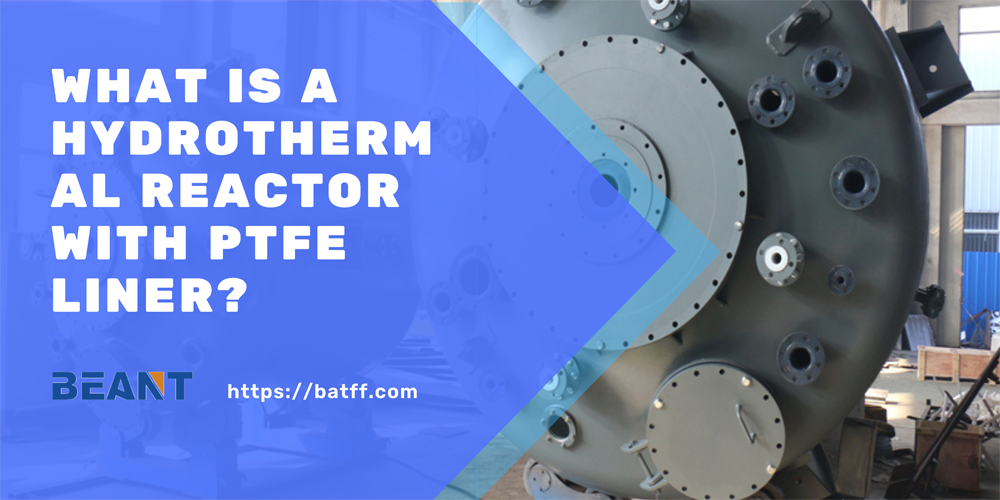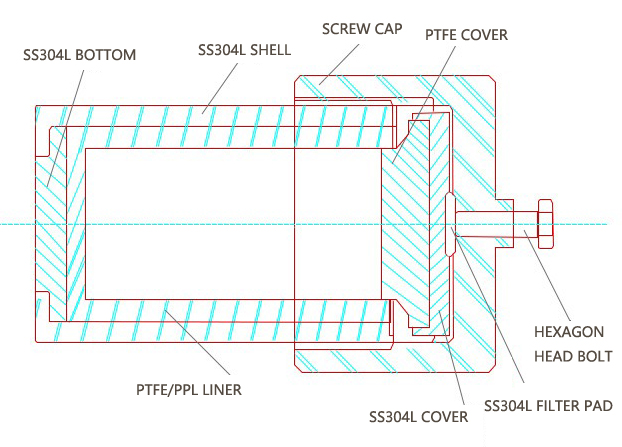
A hydrothermal reactor typically consists of a thick-walled steel container that is capable of handling pressures up to several thousand pounds per square inch (psi). Inside this steel container, a liner made of PTFE (Polytetrafluoroethylene) plays a crucial role. The PTFE liner is not only resistant to heat and chemical reactions but also prevents any contamination of the samples inside, maintaining the purity of the synthesized products. This feature is essential for research and industrial applications where material purity is paramount.
Hydrothermal reactors can vary in size from small benchtop units for laboratory experiments to larger systems used in industrial applications. The choice of reactor size directly relates to the volume of material needed and the specific requirements of the synthesis process.
By utilizing this technology, researchers and engineers can control the crystallization process of materials, influencing their physical properties such as size, shape, and crystalline structure. This control is vital for applications in electronics, optics, and materials engineering, where specific material characteristics are required for functional purposes.
Polytetrafluoroethylene (PTFE), commonly known by the brand name Teflon, is a synthetic fluoropolymer of tetrafluoroethylene that has numerous applications due to its unique properties. In the context of hydrothermal reactors, PTFE liners are crucial because they provide exceptional resistance to extreme temperatures and chemical reactions. This section explores why PTFE is the material of choice for these applications.
PTFE is valued in chemical engineering and materials science for its:
High melting point (327°C): Suitable for processes involving high temperatures.
Chemical inertness: Resists almost all chemicals and solvents.
Low coefficient of friction: Provides a non-stick surface.
High electrical resistance: Ideal for applications requiring insulation.
Non-reactive nature: Prevents contamination of sensitive reactions.
These properties make PTFE an ideal choice for liners in hydrothermal reactors, where maintaining the purity and integrity of materials under extreme conditions is essential.
Hydrothermal reactors are designed to withstand extreme conditions of temperature and pressure, making their construction critical for safety and efficiency. The design of these reactors often includes several key components, each tailored to facilitate specific types of chemical reactions and material synthesis. Central to their functionality is the PTFE liner, which plays a significant role in ensuring the integrity and success of the processes conducted within.

Outer Shell: Typically made from durable metals like stainless steel, capable of withstanding high pressures and temperatures.
PTFE Liner: Serves as a protective barrier inside the reactor, preventing any reaction between the contents and the metal of the outer shell.
Sealing System: Includes gaskets and screw caps designed to maintain airtight conditions, essential for maintaining the required internal pressure.
Modular Design: Many hydrothermal reactors feature a modular design, allowing for parts like the PTFE liner to be easily replaced or customized according to experimental needs.
Safety Features: Includes pressure release valves and temperature control systems to prevent accidents due to overpressure or overheating.
| Feature | Specification |
| Pressure Limit | Up to 2000 psi |
| Temperature Range | Up to 250°C |
| Liner Material | PTFE |
| Typical Volume | 25 mL to 2 L |
| Safety Mechanisms | Pressure relief valves, temperature monitors |
PTFE liners are not just a component; they are a crucial enhancement in hydrothermal reactors that drive their efficiency and safety. Their unique properties make them indispensable in many high-stress chemical environments. Below, we detail the main benefits that PTFE liners bring to hydrothermal synthesis.
One of the most significant advantages of using PTFE liners is their excellent chemical resistance. PTFE does not react with most chemicals, making it ideal for experiments involving highly corrosive substances or conditions where any contamination could lead to skewed results or dangerous reactions.
PTFE's ability to withstand high temperatures without degrading makes it perfect for use in hydrothermal reactors, which operate under both high pressure and high temperature. This resilience ensures that the liners do not leach contaminants into the reaction mixture, maintaining the integrity of both the sample and the reactor.
The inert and stable nature of PTFE reduces the risk of unwanted chemical reactions, which is crucial in high-pressure environments. Additionally, the non-stick surface of PTFE liners prevents the build-up of materials on the reactor walls, simplifying cleaning and maintenance while reducing potential safety hazards.
Although initially more expensive, PTFE liners are a cost-effective investment in the long term due to their durability. Resistant to both physical and chemical wear, these liners extend the life of hydrothermal reactors, reducing the need for frequent replacements and downtime.
PTFE liners simplify the operation of hydrothermal reactors. Their non-stick properties ensure easy removal of products, reducing time and labor involved in post-reaction clean-ups. This efficiency is particularly valuable in research and industrial settings where time and resource management are critical.
While PTFE liners offer numerous benefits in hydrothermal reactors, like any material, they also come with their own set of challenges and limitations. Understanding these drawbacks is crucial for users to effectively manage and mitigate potential issues in their specific applications.
PTFE's softness, while beneficial for ensuring chemical inertness and reducing contamination risks, also makes it susceptible to physical damage. This sensitivity can be a drawback in environments where abrasive materials are handled or where mechanical stress is high.
Although PTFE is resistant to most chemicals, it can be permeable to certain gases under specific conditions. This characteristic might affect experiments requiring absolute containment and could lead to cross-contamination if not properly managed.
Despite its high melting point, PTFE has operational limits in terms of temperature and pressure. Exceeding these limits can lead to deformation or failure of the liner, which could compromise reactor integrity and safety.
The cost of PTFE liners is higher than some alternative materials, which can be a significant factor for laboratories operating on limited budgets. The initial investment may be offset by the durability and efficiency gains, but the upfront cost is still a consideration for many.
Hydrothermal reactors with PTFE liners are not just limited to academic research settings; they find significant applications across various industries, each benefiting from the unique properties of PTFE. Here, we explore some of the primary areas where these reactors are effectively utilized.
In the field of materials science, hydrothermal reactors are indispensable for the synthesis of crystals, ceramics, and composite materials. The controlled environment provided by the PTFE liner ensures that products are free from impurities, which is crucial for developing materials with specific optical, electrical, or mechanical properties.
Researchers in geology and mineralogy use hydrothermal reactors to simulate the natural geological processes that occur over millennia. This application helps in studying the formation of minerals and developing synthetic versions of gems and other geological structures.
Hydrothermal reactors are also employed in environmental science for the synthesis of adsorbents used in pollution control. The ability to create tailored materials that can capture heavy metals or other pollutants from air and water is an invaluable application of this technology.
In pharmaceuticals and biotechnology, hydrothermal synthesis facilitated by reactors with PTFE liners is used to create advanced drug delivery systems and biomaterials. The non-reactive nature of PTFE ensures that no unwanted byproducts contaminate the highly sensitive pharmaceutical compounds.
The energy sector benefits from hydrothermal reactors in the development of new materials for batteries and fuel cells. These materials often require high purity and precise chemical composition to function efficiently, attributes that are achievable through hydrothermal synthesis.
Maintaining hydrothermal reactors, particularly those equipped with PTFE liners, is crucial for ensuring their long-term performance and safety. Proper care not only extends the life of these reactors but also maintains the accuracy and purity of the experiments conducted. Here are some key maintenance tips and best practices.
Routine Checks: Regularly inspect the reactor and its components for any signs of wear or damage, especially the PTFE liner, which can be susceptible to scratches or deformities.
Cleaning Protocols: Clean the reactor after each use to prevent material build-up. PTFE liners should be cleaned with non-abrasive materials to avoid scratching the surface.
Careful Handling: Handle PTFE liners with care to avoid punctures or tears. Always ensure that tools and other equipment are free from sharp edges when in contact with the liner.
Proper Storage: Store the reactor and its components in a clean, dry place to avoid any chemical or environmental degradation.
Liner Replacement: Replace the PTFE liner if any signs of degradation, such as thinning or flaking, are observed. This is critical as even minor imperfections can compromise the reactor’s performance.
Seal Integrity: Regularly check and replace the seals and gaskets to ensure that the reactor remains airtight and capable of withstanding the required pressures.
Monitor Conditions: Regularly monitor the operating temperature and pressure within the reactor. Exceeding the recommended limits can cause damage to the PTFE liner and other reactor components.
Table 2: Maintenance Checklist for Hydrothermal Reactors with PTFE Liners
| Maintenance Task | Frequency | Notes |
| Inspection of Liner | After each use | Check for scratches or signs of wear. |
| Cleaning | After each use | Use soft, non-abrasive cloths or sponges. |
| Seal and Gasket Check | Monthly | Replace if any signs of wear are noticed. |
| Temperature and Pressure Checks | Continuous | Use monitoring devices to track. |
Hydrothermal reactors equipped with PTFE liners are indispensable tools in the fields of material science, geology, environmental science, and more. These reactors simulate extreme geological processes under controlled laboratory conditions, allowing researchers and industries to synthesize novel materials with unique properties. The PTFE liners within these reactors are crucial for ensuring chemical inertness, high temperature resistance, and operational safety, making them ideal for a wide range of applications.
Feel free to leave your message on our board. If you're looking to inquire about prices or place an order, this is the right place! Let us know the details of your needs, and our team will get back to you with a personalized quote as quickly as possible. We're here to ensure your experience is seamless and satisfactory. Share your requirements or ask any questions you might have - we're eager to assist and look forward to doing business with you!
Name:Tim
Phone:+86-15716151880
Email:[email protected]
Company:BEANT
Address:No. 28, Luoshen Road, Luoshe Town, Huishan District, Wuxi City, Jiangsu Province
